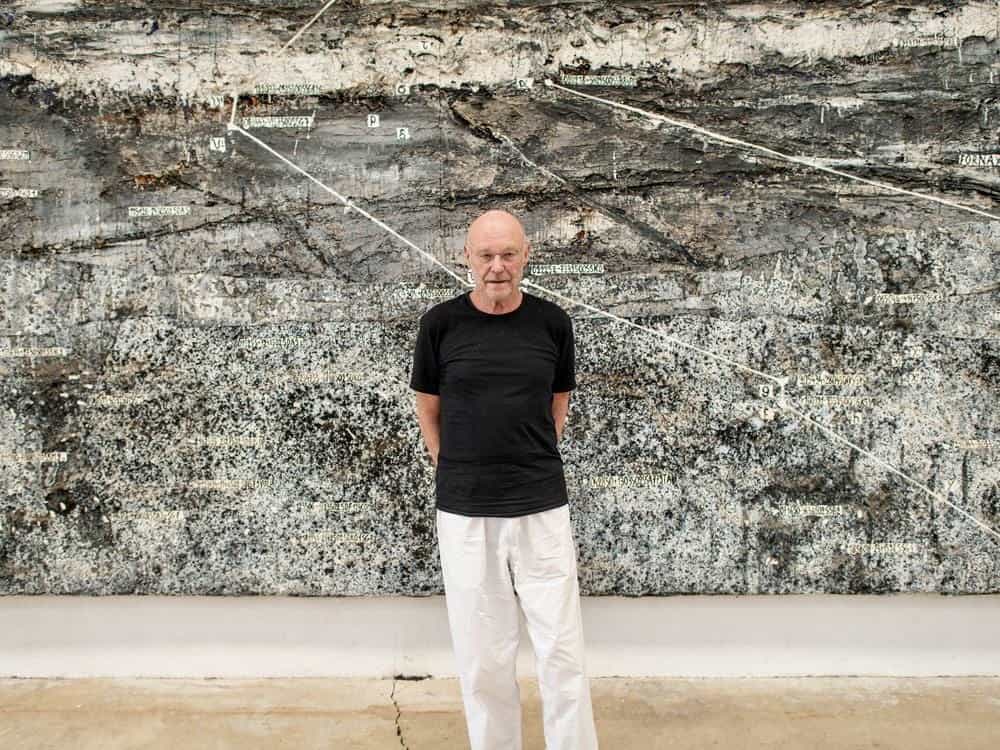Fusing art and literature, painting and sculpture, Anselm Kiefer engages the complex events of history and the ancestral epics of life, death, and the cosmos. His monumental body of work represents a microcosm of collective memory, visually encapsulating a broad range of cultural, literary, and philosophical allusions, from the Old and New Testaments, Kabbalah mysticism, Norse mythology, and Wagner’s Ring cycle to the poetry of Ingeborg Bachmann and Paul Celan. In reflecting on Germany’s postwar identity and history, he also grapples with the national mythology of the Third Reich. Kiefer’s boundless repertoire of imagery is paralleled only by the breadth of mediums he employs.
Fusing art and literature, painting and sculpture, Anselm Kiefer engages the complex events of history and the ancestral epics of life, death, and the cosmos. His monumental body of work represents a microcosm of collective memory, visually encapsulating a broad range of cultural, literary, and philosophical allusions, from the Old and New Testaments, Kabbalah mysticism, Norse mythology, and Wagner’s Ring cycle to the poetry of Ingeborg Bachmann and Paul Celan. In reflecting on Germany’s postwar identity and history, he also grapples with the national mythology of the Third Reich. Kiefer’s boundless repertoire of imagery is paralleled only by the breadth of mediums he employs.
Kiefer was born in Donaueschingen, Germany, in 1945, during the closing months of World War II. After studying law and Romance languages, he attended the Albert-Ludwigs-Universität in Freiburg im Breisgau and the Staatliche Akademie der Bildenden Künste Karlsruhe, while maintaining contact with Joseph Beuys. From 1971 to 1992, he lived and worked in Hornbach, Buchen, and Höpfingen, Germany; since then, he has lived and worked in France.
Kiefer’s oeuvre encompasses paintings, vitrines, installations, artist’s books, and an array of works on paper, including drawings, watercolors, collages, woodcuts, and photographs. The physical elements of his practice—from gold leaf, lead, concrete, and glass to textiles, tree roots, and burned books—are as symbolically resonant as they are wide-ranging. By integrating, expanding, and regenerating imagery and techniques, Kiefer brings to light the importance of myth and memory, the sacred and the spiritual.
From the 1970s onward, Kiefer’s work has been shown at major museums worldwide in solo exhibitions with a variety of formal and thematic foci. A large-scale mid-career retrospective at the Art Institute of Chicago in 1987 (which traveled to the Philadelphia Museum of Art; Museum of Contemporary Art, Los Angeles; and the Museum of Modern Art, New York, through 1989) greatly expanded the artist’s American audience. Bücher 1969–1990 at the Kunsthalle Tübingen, Germany, in 1990 (which traveled to Kunstverein München, Munich; and Kunsthaus Zürich through the following year), gathered his artist’s books, detailed his technique of painting over photographs, and explored his use of materials such as sand and straw. And Heaven and Earth, organized by the Modern Art Museum of Fort Worth, Texas, in 2005 (which subsequently traveled to Musée d’Art Contemporain de Montréal; Hirshhorn Museum and Sculpture Garden, Washington, DC; and San Francisco Museum of Modern Art through 2007), featured paintings, sculptures, and books from throughout Kiefer’s career, examining the artist’s fascination with the celestial and earthly realms. Other major exhibitions have included a survey at the Royal Academy of Art, London (2014); L’Alchimie du Livre, an exhibition of book works at the Bibliothèque nationale de France, Paris (2015); and the artist’s first French retrospective at the Centre Pompidou, Paris (2015–16).
In 2019, Kiefer mounted an exhibition at Couvent Sainte-Marie de La Tourette, a monastery in France designed by Le Corbusier, where he was inspired by the materiality of the architecture to install a variety of works in dialogue with the site. In 2020, he produced new works for Paris’s Panthéon, including a permanent installation of six vitrines. Together with a composition by French contemporary composer Pascal Dusapin, they formed a joint commission by President Emmanuel Macron, the first of its kind for the site since 1924.
Other recent exhibitions include Livres et xylographies (Books and Woodcuts), Fondation Jan Michalski pour l’écriture et la littérature, Montricher, France (2019); Pour Paul Celan (For Paul Celan), Grand Palais Éphémère, Paris (2021–22); Questi scritti, quando verranno bruciati, daranno finalmente un po’ di luce (Andrea Emo) (These writings, when burned, will finally cast a little light [Andrea Emo]), Palazzo Ducale, Venice (2022–23); La photographie au commencement (Photography at the beginning), Lille Métropole Musée d’art moderne, d’art contemporain et d’art brut, Villeneuve d’Ascq, France (2023–24); and Angeli Caduti (Fallen Angels), Palazzo Strozzi, Florence, Italy (2024).
In 2022, Eschaton—Anselm Kiefer Foundation opened La Ribaute, Kiefer’s former studio-estate in Barjac, France, to seasonal public guided visits.
